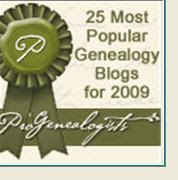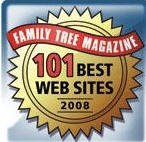I have a few points of disagreement concerning some of Scott's claims and wrote a comment to the original post at EOGN.
Although most genealogists use FamilyTreeDNA.com because it has the biggest DNA databases in the industry and within that is the largest comparative Jewish DNA database - very useful to Jewish genealogists - and although Scott was generally very positive in his comments regarding FTDNA, there were some things I disagreed with (see red highlights below) as an administrator or co-administrator of three projects.
Scott writes:
Here's the important facts about FTdna. They have the most DNA tests by far. Most of the tests are from people in the US. This is a big help for finding your family links in the US. But FTdna is not the best for outside the US. They have done specialized tests of various groups, and they are doing the National Geographic Genographic study of 100,000 people worldwide; however, most of these don't have pedigrees and so are of limited use for genealogy. FTdna is also great for helping you link up with people who match you.I found it strange that Scott says "FTdna is not the best for outside the US," when Jewish genealogists and many of other heritage find international links all the time. One story I will be writing about extensively very soon is that of a former British family now living in Israel who has just found a perfect genetic match to a family (no longer Jewish) with the same name in Poland. I think three countries involved (the US isn't one of them) makes this international. BINGO! There are many other cases.
Many Jewish genealogists do not post their pedigrees online at FamilyTreeDNA or anywhere else where unknown persons can view or copy it. If two people match at 37 or 67 markers, they are related, whether there is an online pedigree or not. Those matches will each be informed and they can contact each other - if permission has been granted - to exchange information and see where the connection is made. You do not need to first see a pedigree to find a DNA genetic match.
When you ask to join a specific project at FamilyTreeDNA, the administrator will ask relevant questions about where you think your family originates, what information you have on the earliest known ancestor and other pertinent questions to see if there is a possibility the two families match up and that it makes sense for you to join that project, particularly if the surname is very common.
Scott is correct when he says that you can't play DNA Bingo without getting a test done and that the more markers the better. An individual might have many matches at 12 markers but the connection to a contemporary connection disappears at 37 or 67 markers; 12 markers is just the screening and indicates a relationship very far in the past. More markers tested mean you can bring the relationship forward into a more genealogically useful timeframe.
Writes Scott:
At 37 and 67 markers, you have a test that will determine if you are related to someone, even if they have a different surname.Many surnames are very recent, only 200 or fewer years old - and some much newer - such as most Ashkenazi Jewish names. Sephardic family names can be found 10 centuries ago in Spanish archives and the same names, with variations, are still found today.
Scott is correct, of course, that the administrator of a FamilyTreeDNA project can be your new best friend, as s/he can answer detailed questions about the participants already tested, whether or not it is the project for you, and provide other information.
One example he detailed was the Hullinger/Hollinger DNA Project.
The Hullinger/Hollinger DNA study has 5 matching tests with pedigrees. The pedigree I did this work for had no confirmed link with Hollinger beyond their third generation. Their DNA test confirmed the link between Hullinger and Hollinger and provided a paper trail that had been lost. I combined the pedigrees to produce a super-pedigree, showing how they all connect. Click here for the Hullinger/Hollinger DNA research page. Some of the lines didn't know how they connected until we compared them. An interesting bit of information was that their DNA type or Haplogroup was J2. This is often associated with Jewish DNA. While this line of Hollingers originated in Switzerland, we turned up Hollinger family members who died in Nazi death camps, mostly from Romania and Poland.Read Scott Norton's complete post (and the comments) at Dick Eastman's site at the link above.
























This is Craig Hullinger. Scott Norton has been very helpful to me.
ReplyDeleteJust completed our genetic test. It confirmed out Swiss Connections, but also showed that our J Haplogroup originated in the middle east, and is probably Jewish. Very interesting.
I put the info on a blog
http://hullingerdna.blogspot.com/